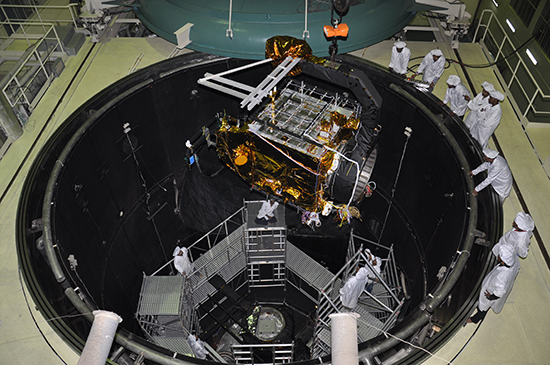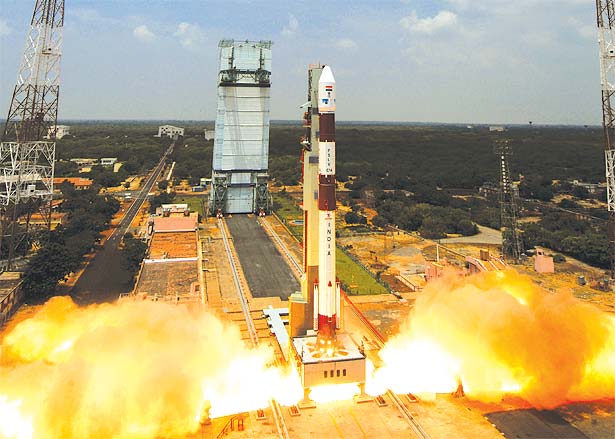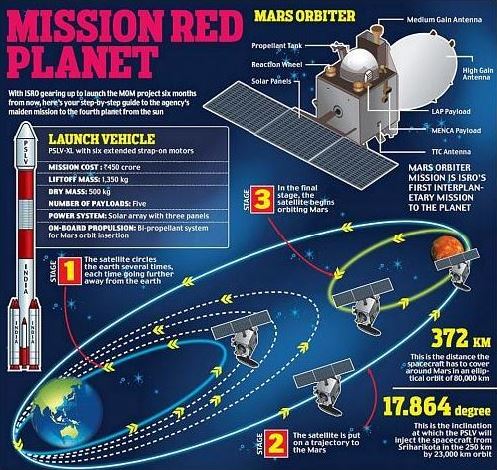
The Indian Space Research Organisation (ISRO) has announced that it will attempt to launch its first mission to Mars on the afternoon of 5 November 2013. According to a brief news release, issued earlier today (Tuesday), ISRO revealed that the liftoff of its Polar Satellite Launch Vehicle (PSLV) with the Mars Orbiter Mission (MOM)—also known as “Mangalyaan” (Hindi for “Mars Craft”)—is scheduled to take place at 2:36 p.m. India Standard Time (5:06 a.m. EDT). With the current “launch window” to reach Mars due to close on 19 November, all eyes will be on India in the coming days, as the world’s second most populous nation reaches for the Red Planet.
Originally targeted for launch on 28 October, preparations for the long-awaited mission proceeded without incident at the Satish Dhawan Space Centre, on the barrier island of Sriharikota, in India’s southern state of Andhra Pradesh. This was quite remarkable, in view of the need to evacuate more than 64,000 people from the region during the recent onslaught of Cyclone Phailin. On 17 October, the Launch Authorisation Board met to approve the installation of the MOM/Mangalyaan spacecraft atop the four-stage PSLV booster. Last Saturday, ISRO Chairman Dr. K. Radhakrishnan channel told India’s Hindi-language NDTV news channel that the spacecraft had been fueled and was in the process of being mated to the rocket. However, the Deccan Chronicle explained that the Board had “met inconclusively” and would meet again on Tuesday, 22 October.
Mother Nature has also conspired against the mission, with poor weather having delayed by several days the arrival of Marine Vessel (MV) SCI Nalanda—the main ISRO ship to be stationed in the Pacific Ocean to monitor the PSLV’s ascent—in Suva, the capital of Fiji. The Nalanda was expected to reach Suva on Saturday, 19 October, but according to the Fiji Times did not arrive until yesterday (Monday). “The ship…was delayed to Suva as it entered Fiji’s exclusive economic zone (EEZ), facing rough seas and low pressure,” explained the Times. The Nalanda docked at the King’s Wharf on Monday night. A second ISRO ship, the MV SCI Yamuna, is already in Fiji. Both vessels have been provided by the Shipping Corporation of India and carry tracking terminals which will relay real-time data about the latter phases of the launch and the release of the MOM/Mangalyaan spacecraft, which will occur high above the South Pacific.

With both ships in position for testing, the Nalanda and the Yamuna will soon be directed to their operational locations for upcoming mission. According to the Fiji Times, the Nalanda “is required to be located around 19 degrees South latitude and 160 degrees West longitude,” whilst the Yamuna will operate at 20 degrees South latitude and 130 degrees West longitude. When they are both on-station, the two ships will be about 3,450 miles (5,550 km) apart … and will both reside more than 10,350 miles (16,650 km) from India. “For any ship to travel such a long distance at one shot,” explained Vinod Kumar, India’s High Commissioner to Fiji, “is very difficult and impractical.”
Mr. Kumar added that the strategic location of Fiji and its capital, the port city of Suva, served the ISRO vessels “as a source for topping up the essential commodities … and facilitating the refueling of the ships to enable these ships to sail further.” The archipelago lies in the southwest Pacific Ocean, about 1,300 miles (2,000 km) northeast of New Zealand’s North Island, and will play a critical role in MOM/Mangalyaan’s ascent to orbit. The ignition of the PSLV’s fourth-stage motor—and injection of the spacecraft into space—is anticipated to occur somewhere high above Fijian airspace. As part of goodwill gestures between the two nations, India planned to present a model of the rocket and the Mars probe to Fiji’s president, Epeli Nailatikau.

As discussed in a recent AmericaSpace article, the mission has aroused positive and negative debate in equal measure. Although its price tag—which may climb as high as $100 million—is relatively benign by the standards of U.S. missions to the Red Planet, its critics have pointed to India’s power failures, its droughts and its extreme weather events and have questioned if it is a worthwhile expense. ISRO Chairman Dr. Radhakrishnan responded to these concerns in a Tuesday interview for The Hindu newspaper. “The Moon, Mars and the Sun were part of our country’s long-term vision as laid out by the Advisory Committee on Space Sciences,” he explained. “Scientifically and technologically, we cannot afford to miss such missions. We have a three-pronged space program of satellites, launch vehicles and scientific and planetary exploration, in that order, all of which are equally important. Like the fingers on your hand, you need them all.”
Questioned about the relevance of the MOM/Mangalyaan mission to the ordinary Indian in the street, Dr. Radhakrishnan stressed that for technologists it was “a challenge”, for scientists it was “an opportunity to learn about Mars” and for the common man or student it was “a matter of pride that our country can do such a complex mission”. He pointed out that ISRO’s budget represents 0.34 of India’s national budget and that it is divided between satellite development (55 percent), launch vehicles (35 percent) and the remainder for scientific and planetary exploration, which has included the recent Chandrayaan-1 lunar orbiter. In addition to MOM/Mangalyaan, ISRO plans to launch the Chandrayaan-2 orbiter, lander and roving vehicle to the Moon in 2015.
Described as “a technology demonstration project,” MOM/Mangalyaan’s primary task is to prove that India has the technical capability to design, plan, manage, launch and operate a deep-space mission across the vast gulf to reach the Red Planet. The spacecraft carries a payload of five scientific instruments—the Methane Sensor for Mars (MSM), Mars Colour Camera (MCC), Mars Exospheric Neutral Composition Analyser (MENCA), Thermal Infrared Spectrometer (TIR) and Lyman-Alpha Photometer (LAP)—and will be dedicated to developing a clearer understanding the morphology, topography, and mineralogy of the Martian surface, the dynamics of its tenuous upper atmosphere, the effects of the solar wind and radiation, and the nature of the planet’s large moon, Phobos.
“Such scientific missions post very tough challenges to technologists,” said Dr. Radhakrishnan. “Some of the outcomes—for example, the in-built autonomy we are providing in this spacecraft—can become a reality as a product or system and be used in satellites to improve their efficiency. So they percolate to application, which is our main objective. It could be something like forecasting cyclones. There is always relevance for a mission such as this.”
Want to keep up-to-date with all things space? Be sure to “Like” AmericaSpace on Facebook and follow us on Twitter: @AmericaSpace
Missions » MOM »




I like the valuable info you provide for your articles. I’ll bookmark your blog and take a look at once more here frequently. I am moderately sure I will learn many new stuff right here! Best of luck for the following!
Thank you for covering this information, very good article. No single country can possibly send manned mission to Mars, all these missions by various countries (four so far counting India if this succeeds) will gather information that will finally enable human beings to reach and survive on Mars.